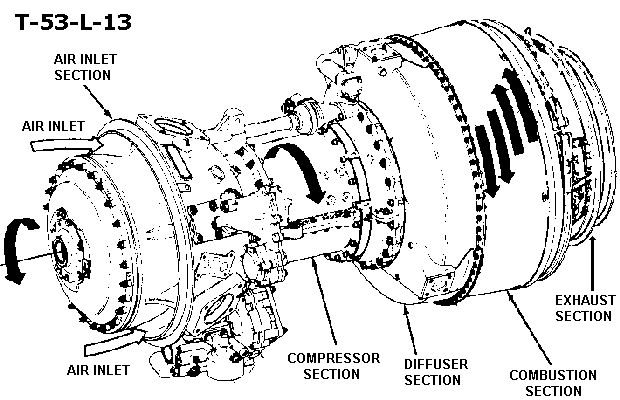T-53-L-13 Gas Turbine Engine
The T-53-L-13 engine is a Free Power type turbine. Free power indicates that
engine operation involves two mechanically independent internal stages (systems). The
compressor rotor and gas producer turbine rotors makeup the n1 stage, and the
power turbine rotors with their output power shaft makeup the n2 stage. The
symbol ' n ' refers to rotation (rpm) of the two independent stages. Actually the n1
and n2 components rotate in opposite directions and at different rpm. In the
designation, the T is for turbine, 53 for military number, L for Lycoming (manufacturer),
and -13 for the number of modifications to the original engine. The engine is capable of
producing 1400 shp (shaft horsepower) at 64 psi of torque on a standard day (59 degrees F)
at sea level (29.92 HG). However, it has been limited to 1100 shp (50 psi torque) because
of the power train limitations and world wide application.
There are five structural sections of the engine. The five sections are interdependent
and support the rotating parts (n1 and n2) internally and provide
external attachment points for the support systems and air frame accessories.
Directional references are as follow:
Front (cold) end - Where power is extracted.
Rear (hot) end - exhaust.
Right and Left - determined by viewing engine from rear.
Bottom and Top - Six and twelve o'clock positions.
Direction of rotation - n1 counterclockwise and n2 clockwise

The T-53-L-13 engine is constructed of five interdependent sections. They
are designed to provide an annular (360 degree ring) flow path for the air and hot gases
as they move through the engine. The sections support all internal rotating parts and
external support system components. From front to rear the five sections that makeup the
engine are the air inlet, compressor, diffuser, combustor, and exhaust diffuser.
| Updated:
17 January 2013
|
|
Born on 17 February 1999
|




